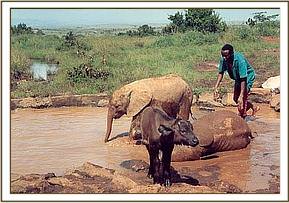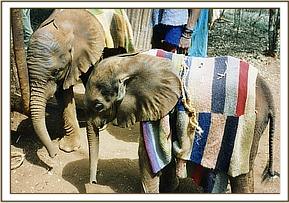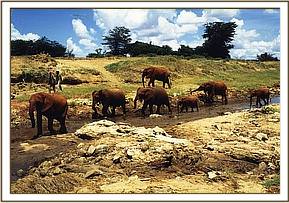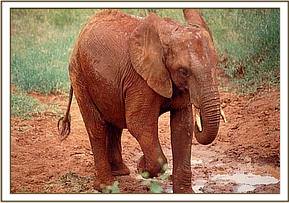








Has fully embraced his wild life in Tsavo East National Park
Current age
38 years old
Gender
Male
Rescued date
2 March 1987
Rescue location
Samburu, Maralal National Park
Date of birth (estimate)
1 February 1987
Reason orphaned
Poaching
Age at rescue
0 months old (approx)
Current location
Living Wild
It is not known how many elephants were killed or wounded on the day that Olmeg was left an orphan, for it was during a period when poaching was still completely out of control throughout the country, with elephants dying daily in large numbers everywhere, the Government Department charged with their protection often the main poaching culprits. The International Ivory Ban, which brought poaching under control, was still 3 years hence.
This tiny calf fell into a deep trench as his family were running for their lives and there he was left for dead by the fleeing herd. He was found a day later by herdsmen, sunburnt, confused and very dehydrated. They took him to the nearby Maralal Safari Lodge, where he was kept for the next week, being fed on cows’ milk and grated carrots, which, of course, did him no good at all. Finally, when he looked as though he was going to die, the manager (who, nevertheless, had done his best) brought him to us, having heard that Daphne knew something about elephant orphans.
The baby was in a pitiful state, suffering from serious diarrheoa (due to the incorrect diet) extremely sun damaged ears and a very septic umbilicus oozing pus. Meanwhile, we tried hard to persuade Olmeg to spend his nights in a small stone chicken house (minus the chickens!), with just one of Daphne’s dresses, bearing her scent to represent that vital human presence, but he was having none of it, and the midnight walks around the yard continued, loud protests punctuating the night about the new sleeping arrangement. Unhappily, our Ranger Assistant didn’t work out either, for he lacked the empathy needed, and Olmeg hated him with a passion, refusing even to accept milk from him. Hence, the new Elephant Keeper had to be returned with thanks and we then set about recruiting our own, and, of course, more than just one, so that the men could have time off. Gradually, they took over the Orphan duties, and Daphne and Jill could not only catch up on lost sleep, but also turn their attention to the many other duties that had been sadly neglected!
Olmeg was a true survivor. Miraculously, not only did he make a full recovery, but he weathered the many human errors in relation to his care to which we unwittingly subjected him. He taught us a great deal that we did not previously know, one being that even newborn elephants need space and become very claustrophobic when too closely confined. We knew now that the next batch of stables would have to be made a good deal larger. The next lesson was that the elephants choose their Keepers, and if an orphan does not bond with a Keeper, the man cannot become part of the elephant’s human “family” because he does not have the genuine emotional attachment needed. Elephants have an uncanny ability to read one’s heart and mind so the ingredient of “love”, essential to success, has to come straight from the heart. These any many other tips we learnt from Olmeg.
He was soon joined in the Nairobi Nursery by other poaching victims, namely Taru, Dika, Ndume and Malaika and, in the fullness of time, all graduated to become part of “Eleanor’s” adopted family in Tsavo East National Park to begin their gradual rehabilitation back into the wild community. At that time, “Eleanor” was over 30 years old, the longstanding Matriarch of the Tsavo orphans who had lived through three decades of rampant poaching and suffering in Tsavo, when the wild population was reduced from 20,000 to less than 5,000. By the time Olmeg and the other Nursery elephants joined her, many other youngsters had come into her care, brought in old enough to be given directly to her. One was a young bull named ”Chuma” (the Swahili word for “iron”) and he certainly lived up to the interpretation of his name, for although he was under two when he arrived, he was healthy enough for us to risk completing his milk depend period under close supervision in Tsavo. To have taken him from Eleanor at that time would have caused her immeasurable misery, and she had been subjected to so much already.
During all the years that Olmeg was growing up in Tsavo, no Keeper could begin to match the love he held for Daphne and Jill, who had mothered him in very early infancy back in the Nairobi Nursery. Whenever they visited Tsavo, he greeted them with unbridled joy and excitement, recognizing them instantly, even amongst a crowd of other visitors. When he became a teenager, he, Taru, Chuma and the other orphan bulls, took to spending time away from Eleanor’s group, which was growing year by year, seeking the company of other male friends, as is the way of teenage bulls in elephant society. For several years Olmeg used to return fairly regularly, but these visits became less frequent as time passed. He was last seen in 2002 near the Park’s Sala Gate on the Eastern Boundary, and since then has not been back to the Voi Stockades. That said, it is unlikely that any of the current Elephant Keepers working with the present day orphans would even be able to recognise him, since most have been recruited since he left the fold. His rehabilitation back into the wild community can therefore be said to be successful and complete – in other words, Mission Accomplished, and for us, this is a source of satisfaction and pride. In Tsavo our orphans are offered a quality of life in elephant terms for it is the only Park in Kenya that has the space an elephant needs for that quality of life.
It is not known how many elephants were killed or wounded on the day that Olmeg was left an orphan, for it was during a period when poaching was still completely out of control throughout the country, with elephants dying daily in large numbers everywhere, the Government Department charged with their protection often the main poaching culprits. The International Ivory Ban, which brought poaching under control, was still 3 years hence.

View diary updates from across all our orphan units as written by the Keepers

The Nairobi Nursery is the first, formative step in an orphan’s journey back to the wild. It is the place where calves who have lost everything find family and a future once more.
By adopting, you play a vital role in the life of an orphaned elephant, rhino, or giraffe — helping us provide the round-the-clock, loving attention each one needs and deserves over many years, so they can ultimately reclaim their place in the wild.
Your adoption supports the 100+ orphans in our care at any given time, covering the cost of milk and food supplies, Keepers' salaries, veterinary treatment, and other essentials.

Celebrate your adoption with a personalised certificate, ready for you or your lucky gift recipient to print and display!

Each month, we send a detailed update about our Orphans’ Project direct to your email inbox, featuring photos, stories, and special highlights.

From the latest Keepers’ Diaries to a downloadable image gallery and more, adopters have exclusive access to our content library.






